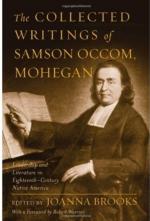|
This section contains 9,512 words (approx. 32 pages at 300 words per page) |

|
SOURCE: “‘This Indian Bait’: Samson Occom and the Voice of Limnality,” in Early American Literature, Vol. 29, No. 3, 1994, pp. 233-53.
In the essay below, Elliott analyzes Occom's discourse in his correspondence, Sermon, and other writings, contending that the rhetorical strategies he employs reflect his precarious position between white and Indian cultures.
In 1759, Samson Occom (1723-1792) became the first Native American to be ordained as a minister of the Christian gospel. As both Mohegan Indian and a Protestant minister, Occom held a socially and discursively precarious position in New England society. Perhaps no one event better encapsulates the complexity of his status than the execution sermon he delivered in 1772, which was soon after published as A Sermon Preached at the Execution of Moses Paul, an Indian. As the title indicates, the offender was indeed another Native American; Moses Paul was a Christian Indian who had been convicted of murdering a...
|
This section contains 9,512 words (approx. 32 pages at 300 words per page) |

|


